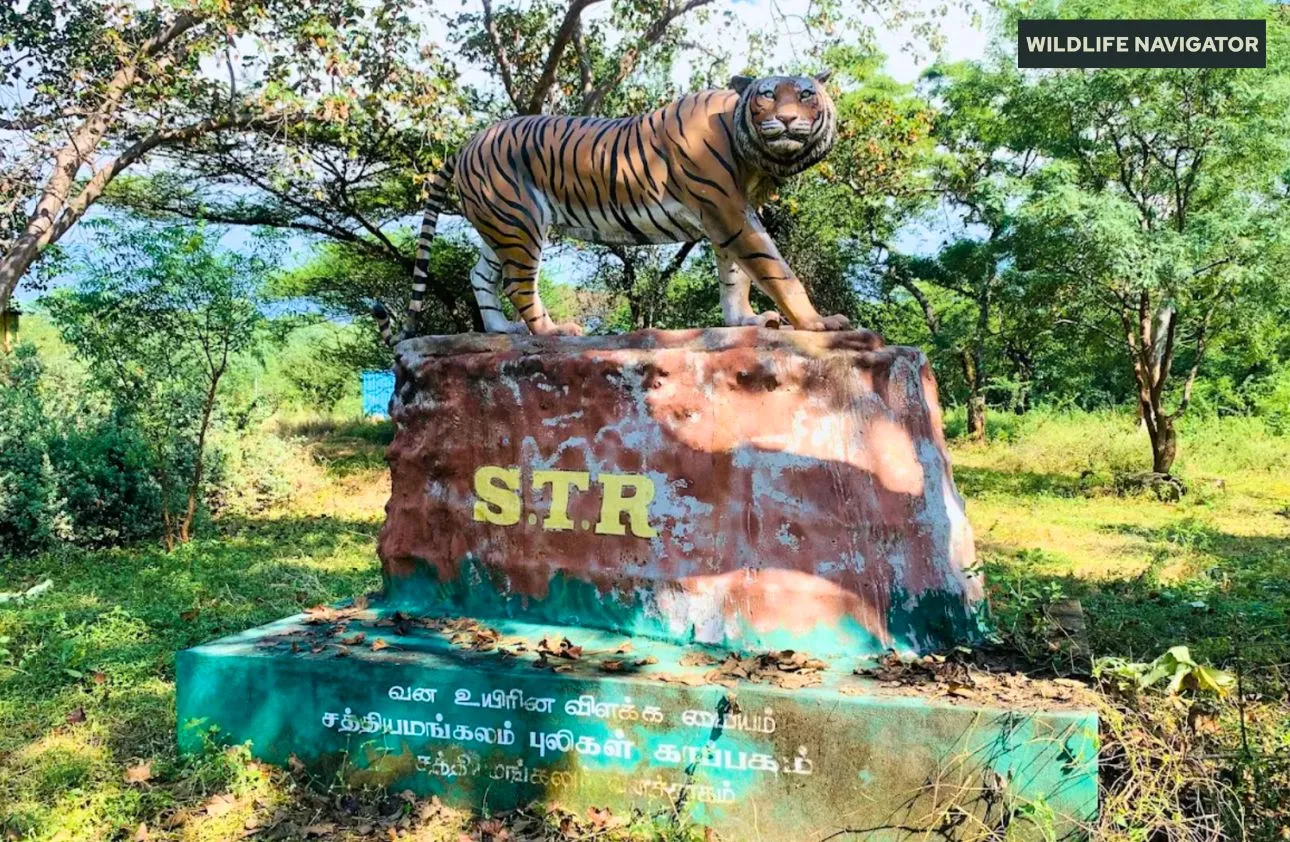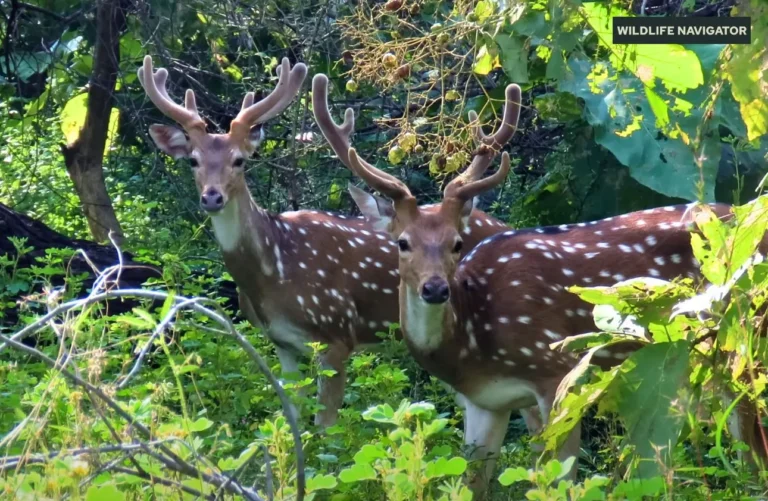Sathyamangalam Tiger Reserve – Complete Wildlife & Travel Guide 2025

Sathyamangalam Tiger Reserve (STR) is one of the most ecologically significant protected areas in southern India. Located in the Erode district of Tamil Nadu, this vast expanse of wilderness forms a critical wildlife corridor linking the Nilgiri Biosphere Reserve with the Eastern Ghats, making it a lifeline for migratory species such as elephants and tigers.
Spanning over 1,400 sq. km, Sathyamangalam boasts diverse landscapes that range from dry deciduous forests and scrublands to lush riverine ecosystems. This geographical variety creates an ideal habitat for a wide range of flora and fauna, including several endangered and endemic species. The reserve is particularly renowned for its growing population of Bengal tigers and Asian elephants, both of which find safe passage through its rugged terrain.
What makes Sathyamangalam even more fascinating is its historical and cultural legacy. Once infamous as the hideout of the bandit Veerappan, the forests today symbolise resilience and transformation, standing as a beacon of successful conservation under Project Tiger. Recognised not just for its wildlife but also for its role in maintaining ecological balance, Sathyamangalam has become a destination for nature lovers, researchers, and responsible travellers alike.
History of Sathyamangalam Tiger Reserve
The history of Sathyamangalam Tiger Reserve (STR) is as dramatic as its rugged landscape. For centuries, these forests served as a natural stronghold for both wildlife and people who depended on them for survival. The region was once part of the traditional hunting grounds of local rulers and also played a strategic role as a passage between Tamil Nadu and Karnataka, owing to its position along the historic Mysore–Tamil Nadu trade routes.
However, in more recent times, the forest came to be associated with the notorious bandit Veerappan, who used the thick vegetation, caves, and river valleys of Sathyamangalam as his stronghold. For decades, his presence cast a shadow over the reserve, discouraging tourism and wildlife protection. After his death in 2004, the forests began to see a transformation, with the government and conservationists focusing on restoring its ecological importance.
Sathyamangalam was first declared a Wildlife Sanctuary in 2008, covering nearly 524 sq. km. Recognising its significance as a tiger habitat and a crucial elephant corridor, it was later upgraded to a Tiger Reserve in 2013 under India’s Project Tiger initiative. Since then, it has emerged as one of the most important protected areas in southern India, boasting a steady increase in tiger numbers as confirmed by the National Tiger Census.
Today, the reserve stands as a symbol of successful conservation, transforming from a land once marked by fear and conflict into a thriving safe haven for biodiversity. Its history reminds us of how landscapes can heal when given protection and care.
Geography & Landscape of Sathyamangalam Tiger Reserve
The Sathyamangalam Tiger Reserve lies in the Erode district of Tamil Nadu, strategically positioned along the border with Karnataka. Covering an area of over 1,400 sq. km, it forms the largest protected forest in the state and plays a vital role as a wildlife corridor linking the Western Ghats and Eastern Ghats. This connectivity is especially significant for wide-ranging species like elephants and tigers, allowing them to move freely across neighbouring reserves such as Mudumalai, Bandipur, and Biligiri Ranganathaswamy Temple Tiger Reserves.
Geographically, Sathyamangalam is a mosaic of hills, valleys, and river systems. It sits at the foothills of the Nilgiris, where elevations range from 750 to 1,800 meters, creating a dramatic variation in terrain. The forests are watered by perennial rivers like the Bhavani, Moyar, and Palar, which not only sustain wildlife but also support agriculture and local communities downstream. Seasonal streams and waterfalls further enrich its ecological diversity.
The reserve’s landscape diversity is equally striking. It encompasses dry deciduous forests, scrublands, thorny thickets, riparian stretches, and moist deciduous patches at higher altitudes. These varied habitats allow Sathyamangalam to support everything from large mammals such as elephants, gaurs, and tigers to delicate species like butterflies, reptiles, and migratory birds.
Another unique feature of Sathyamangalam is its climatic variation. While lower regions often experience dry and hot conditions, the higher elevations remain relatively cooler and more humid. This blend of climatic zones contributes to the reserve’s remarkable biodiversity.
Sathyamangalam as a Tiger Reserve
Sathyamangalam holds a distinguished place in India’s wildlife map as one of the country’s newest yet most significant Tiger Reserves. Declared under Project Tiger in 2013, the reserve has quickly emerged as a stronghold for the Bengal tiger, thanks to its rich prey base, vast landscape, and its position as a crucial corridor connecting multiple protected areas of the Nilgiri Biosphere Reserve.
Status under Project Tiger
When Sathyamangalam was brought under Project Tiger, it marked a major conservation milestone for Tamil Nadu. This recognition provided greater protection, stricter anti-poaching measures, and enhanced funding for habitat management. As a result, the once-threatened tiger population here began to show signs of recovery.
Tiger Population Statistics & Conservation Efforts
According to the All India Tiger Census, Sathyamangalam has seen a steady rise in tiger numbers over the past decade. From being a relatively lesser-known habitat, it now supports an estimated 80+ tigers, making it one of the largest tiger populations in southern India. Intensive patrolling, camera trapping, and community-based conservation have been key to this success. The reserve also benefits from its connectivity with neighbouring habitats like Mudumalai and Bandipur, ensuring genetic diversity among tiger populations.
Other Notable Carnivores
While tigers are the star attraction, Sathyamangalam is also home to a host of other apex predators:
- Leopards, thriving in rocky terrains and dense forests.
- Dholes (Indian wild dogs), which hunt in packs and are often spotted.
- Striped hyenas, a rarer carnivore species, found in drier zones.
- Sloth bears, known for their nocturnal activities and fruit diet.
Together, these carnivores highlight the richness of the food chain in Sathyamangalam, making it a true predator’s paradise.
Major Tiger Sightings Areas (Optional Tip for Visitors)
Tigers are mostly sighted near riverbanks and forest clearings close to the Bhavani and Moyar river valleys, where prey is abundant. The denser parts of the reserve, though harder to access, are also prime tiger habitats.
Tiger Photography Tips (Optional)
- Early morning or late evening safaris offer the best chance of spotting tigers.
- Carry long-zoom lenses for photography since dense vegetation often makes tigers visible from a distance.
- Respect forest rules—silence and patience are the keys to rewarding sightings.
Sathyamangalam, with its robust tiger population and interconnected forest landscape, is not just a protected area—it is a thriving tiger kingdom of the south, symbolising India’s commitment to big cat conservation.
Flora & Fauna of Sathyamangalam Tiger Reserve
The Sathyamangalam Tiger Reserve is a treasure trove of biodiversity, thanks to its diverse habitats that range from dry deciduous forests to moist riverine stretches. This variation in vegetation supports an extraordinary mix of plants and animals, making it one of the richest wildlife regions in southern India.
Flora
The reserve’s vegetation is dominated by dry deciduous forests interspersed with patches of scrublands and thorny thickets. Along the banks of rivers like Bhavani and Moyar, lush riparian forests thrive, creating green corridors even in the drier months. Prominent tree species include teak, sandalwood, bamboo, Terminalia, and Albizia, alongside medicinal plants and shrubs that support both wildlife and local communities.
Fauna
Sathyamangalam is home to over 40 species of mammals, 200+ bird species, and a wide range of reptiles and amphibians.
- Large Mammals: Bengal tiger, Indian elephant, Indian gaur, sloth bear, and sambar deer.
- Carnivores: Leopards, striped hyenas, dholes (wild dogs), and jackals.
- Birds: Indian peafowl, Great Indian Hornbill, vultures, parakeets, and migratory species during winter.
- Reptiles: Mugger crocodile, monitor lizards, pythons, and cobras.
The presence of endangered species like tigers, elephants, and vultures underscores the ecological importance of Sathyamangalam. Its thriving prey base of deer, antelopes, and wild boars ensures a healthy predator population, creating a balanced ecosystem.
With such a vast diversity of flora and fauna, Sathyamangalam is rightly considered a living laboratory of nature, offering endless opportunities for wildlife enthusiasts and researchers.
Conservation & Importance of Sathyamangalam Tiger Reserve
The Sathyamangalam Tiger Reserve is more than just a protected forest—it is an ecological lifeline for southern India. Its location at the junction of the Western Ghats and Eastern Ghats makes it a vital wildlife corridor, ensuring the free movement of elephants, tigers, and other wide-ranging species across connected reserves like Mudumalai, Bandipur, and Biligiri Ranganathaswamy. This connectivity is crucial for maintaining genetic diversity and long-term survival of large carnivores.
Conservation in Sathyamangalam has been strengthened under Project Tiger, with measures such as anti-poaching patrols, camera traps, and eco-development projects for local communities. Once infamous for poaching and smuggling during Veerappan’s era, the reserve today stands as a success story of law enforcement and habitat protection.
The reserve is also a haven for Asian elephants, acting as one of the largest migratory corridors in South India. Protection here directly contributes to the survival of the region’s elephant population, reducing human-wildlife conflict in surrounding villages.
Equally important is the role of Sathyamangalam in combating climate change. Its vast forests act as a carbon sink, regulate water flow in rivers like the Bhavani and Moyar, and preserve soil health, benefiting agriculture and communities downstream.
Safari Experience in Sathyamangalam Tiger Reserve
A safari in Sathyamangalam Tiger Reserve offers travellers a chance to step into the wild heart of Tamil Nadu and witness its untamed beauty up close. While it may not yet be as commercialised as other famous reserves, its raw wilderness, predator-rich landscape, and serene environment make it a hidden gem for wildlife enthusiasts.
Types of Safaris
Visitors can explore the reserve through:
- Jeep Safaris – The most popular option, offering flexible routes through prime wildlife areas.
- Minibus Safaris – Organised group rides, ideal for budget travellers or larger groups.
- Eco-Trekking (Buffer Zones) – Guided treks along designated trails for those who prefer walking amidst nature rather than vehicle rides.
Wildlife Sightings
The reserve is renowned for its sightings of elephants, gaurs, sambar deer, wild dogs, and occasionally tigers. Leopards are often spotted in rocky terrains, while sloth bears and striped hyenas add to the thrill of nocturnal safaris. Birdwatchers will enjoy glimpses of the Great Indian Hornbill, peafowl, parakeets, and migratory raptors during the cooler months.
Best Safari Timings
Safaris usually operate during early mornings (6:00 AM – 9:00 AM) and evenings (3:00 PM – 6:00 PM), when wildlife is most active. The golden light during these hours also makes for excellent photography conditions.
Tips for Visitors
- Book safaris in advance through the official forest department or authorised eco-tourism boards.
- Carry binoculars and long lenses for better viewing in dense forest zones.
- Maintain silence and avoid littering to respect the wilderness.
A safari in Sathyamangalam is not just about spotting a tiger—it’s about experiencing the wilderness in its most authentic form, where every turn in the trail can surprise you with a new sight or sound of the forest.
Best Time to Visit Sathyamangalam Tiger Reserve
The best time to visit Sathyamangalam Tiger Reserve depends on what you wish to experience—wildlife sightings, pleasant weather, or scenic landscapes.
- Winter (November – February): This is the most popular season for visiting the reserve. The weather remains cool and comfortable, making safaris enjoyable. Wildlife sightings are good as animals are more active during the day, and migratory birds also flock to the region.
- Summer (March – June): Although temperatures can soar, summer offers excellent opportunities for spotting wildlife. Animals often gather around rivers and watering holes, increasing the chances of encountering elephants, gaurs, and even tigers. Morning and evening safaris are recommended to avoid the midday heat.
- Monsoon (July – October): The forest transforms into a lush green paradise during the monsoon. However, heavy rains may restrict safaris, and some trails could become inaccessible. This season is best suited for nature lovers and photographers who want to capture the forest at its most vibrant, though big cat sightings may be rarer.
Overall, November to May is considered the ideal period for visitors, balancing pleasant weather and good chances of wildlife encounters.
How to Reach Sathyamangalam Tiger Reserve
Reaching Sathyamangalam Tiger Reserve is convenient as it is well-connected by road, rail, and air to major cities of Tamil Nadu and Karnataka.
By Road
The reserve is located near Sathyamangalam town in Erode district. It lies along National Highway 209 (now NH 948), which connects Coimbatore to Bengaluru via Mysuru. Regular buses, private taxis, and self-drive options are available. From Erode, the reserve is about 65 km, while from Coimbatore it is around 70 km.
By Rail
The nearest major railway stations are:
- Erode Junction (65 km) – a well-connected station with trains from Chennai, Bengaluru, and Coimbatore.
- Coimbatore Junction (70 km) – another convenient option for visitors travelling from southern and western India.
From both stations, one can hire a cab or take buses to Sathyamangalam town.
By Air
The closest airport is Coimbatore International Airport (80 km), with regular flights from Chennai, Bengaluru, Hyderabad, and Mumbai. For international visitors, Bengaluru’s Kempegowda International Airport (250 km) is another option.
Distances from Major Cities
- Coimbatore – 70 km
- Erode – 65 km
- Mysuru – 125 km
- Bengaluru – 225 km
- Chennai – 430 km
With such accessibility, travellers can easily combine a visit to Sathyamangalam with nearby destinations like Bandipur, Mudumalai, and Ooty.
Accommodation Options in and around Sathyamangalam Tiger Reserve
Visitors to Sathyamangalam Tiger Reserve have a variety of accommodation options, ranging from forest rest houses to eco-friendly resorts and nearby hotels. While the reserve itself is relatively undeveloped compared to other tiger reserves, several options provide comfort while keeping you close to nature.
Forest Guesthouses & Rest Houses
The Tamil Nadu Forest Department operates basic guesthouses and rest houses near the reserve’s entry points. These accommodations are ideal for wildlife enthusiasts and researchers who prefer a closer connection to the forest. Booking in advance through the forest department is recommended, especially during peak season (November–May).
Eco-Lodges & Resorts
Several eco-lodges and nature resorts are located near Sathyamangalam town and along the NH 948 corridor. These lodges provide a blend of comfort and wilderness experience, often offering guided safaris, birdwatching tours, and nature walks. They follow sustainable practices, making them perfect for environmentally conscious travellers.
Hotels & Homestays in Nearby Towns
For those seeking more conventional amenities, towns like Sathyamangalam, Erode, and Coimbatore offer mid-range and budget hotels. Homestays in villages near the reserve provide a more authentic experience, allowing visitors to interact with local communities and learn about their relationship with the forest.
Tips for Accommodation
- Book well in advance during peak months.
- Verify whether safaris or guided treks are included in lodge packages.
- Choose eco-friendly options where possible to support sustainable tourism.
Whether you prefer rustic forest stays or comfortable hotels nearby, Sathyamangalam offers accommodations to suit all types of travellers while keeping the wilderness experience intact.
Travel Tips for Visitors
Visiting Sathyamangalam Tiger Reserve requires some preparation to ensure a safe, enjoyable, and responsible experience. Here are key tips for travellers:
- Safari Booking: All safaris should be booked in advance through the Forest Department or authorised eco-tour operators. Morning and evening slots are preferable for maximum wildlife sightings.
- Timing: Early mornings (6:00–9:00 AM) and late afternoons (3:00–6:00 PM) are ideal for safaris, as animals are most active during these hours.
- Clothing & Gear: Wear light-colored, comfortable clothes and sturdy shoes. Carry binoculars, a long-zoom camera, hat, sunscreen, and insect repellent.
- Do’s & Don’ts: Maintain silence during safaris, avoid littering, and never feed or disturb wildlife. Follow all instructions from forest guides.
- Local Guidance: Hiring local guides enhances wildlife spotting opportunities and provides insights into the reserve’s flora, fauna, and history.
- Safety: Keep a safe distance from animals and avoid venturing into unauthorised zones. Mobile connectivity may be limited inside the forest.
By following these simple tips, visitors can enjoy a safe, memorable, and eco-friendly experience in Sathyamangalam while supporting the conservation of this vital tiger habitat.
Nearby Attractions
Sathyamangalam Tiger Reserve is surrounded by several attractions that make a trip to the region even more enriching. Travellers can combine wildlife experiences with cultural, historical, and scenic sites nearby.
1. Bannari Amman Temple
Located about 25 km from Sathyamangalam town, this famous temple dedicated to Goddess Amman attracts thousands of devotees, especially during annual festivals. The temple’s serene surroundings offer a peaceful stop for travellers exploring the region.
2. Bhavanisagar Dam
One of the largest earthen dams in the world, Bhavanisagar Dam, is around 50 km from the reserve. Set against rolling hills and lush farmland, it’s an ideal spot for picnics, photography, and enjoying tranquil sunsets.
3. Nilgiri Biosphere & Bandipur Link
Sathyamangalam serves as a gateway to the Nilgiri Biosphere Reserve. Visitors can plan trips to nearby Bandipur Tiger Reserve or Mudumalai, experiencing multiple wildlife habitats and increasing chances of tiger and elephant sightings.
4. Waterfalls & Trekking Spots
The region surrounding the reserve has several scenic waterfalls, hills, and trekking trails that attract nature enthusiasts. Places like Chinnakallar and Moyar Valley offer adventurous day treks combined with birdwatching and photography opportunities.
5. Rural & Cultural Experiences
Nearby villages offer a glimpse into local rural life, traditional farming practices, and Tamil Nadu’s rich cultural heritage. Homestays in these areas provide an authentic experience for travellers seeking immersion in local lifestyles.
These attractions complement the wildlife experience, allowing visitors to explore nature, culture, and adventure all in one trip while visiting Sathyamangalam Tiger Reserve.
Conclusion
Sathyamangalam Tiger Reserve stands as one of southern India’s most important wildlife sanctuaries, offering a unique combination of rich biodiversity, rugged landscapes, and cultural heritage. From the majestic Bengal tigers and roaming elephants to the rare birds and endemic plant species, the reserve is a thriving ecosystem that highlights the success of modern conservation efforts under Project Tiger.
Beyond its wildlife, Sathyamangalam plays a critical ecological role as a corridor connecting the Western and Eastern Ghats, ensuring the safe passage and genetic diversity of wide-ranging species. Its rivers, hills, and forests contribute not only to biodiversity but also to the livelihoods of local communities, sustainable tourism, and climate regulation.
For travellers, Sathyamangalam is more than a destination—it’s an immersive experience where every safari, trek, and nature walk offers a chance to witness the harmony of the wild. Responsible visitation, guided safaris, and eco-friendly accommodations ensure that the forest remains protected for future generations.
A visit to Sathyamangalam Tiger Reserve is a journey into the heart of southern India’s wilderness, where adventure meets conservation, and every glimpse of its wildlife inspires awe and respect for the natural world.





